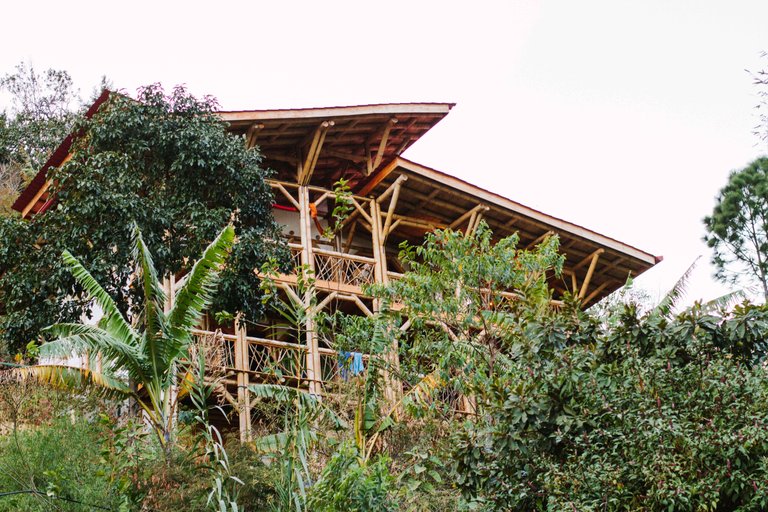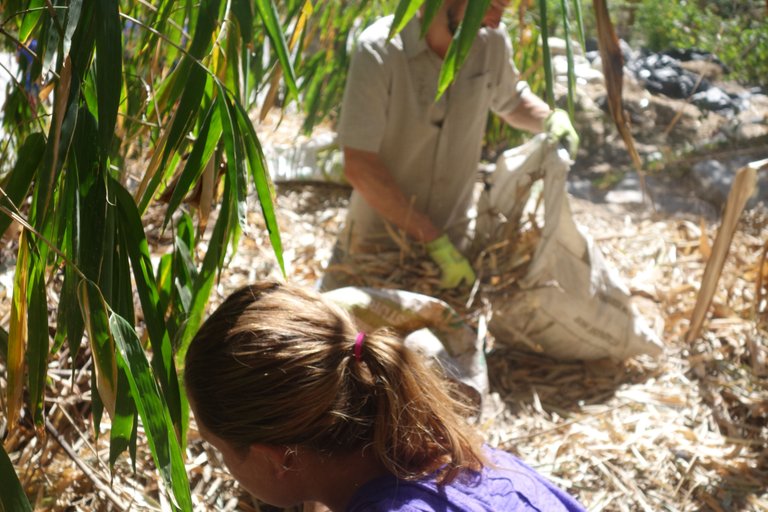
Last week one of our guests was lounging on the balcony in hopes of witnessing the Super Blue Blood Moon when he spotted a fiery glow down below. Alarmed, he rushed down to discover a hefty-sized pile of dried bamboo leaves ablaze. He shouted up for help and was soon joined by other guests, staff and volunteers who quickly stomped the flames out, reducing it to a smoldering pile of orange embers. Thanks to their quick-thinking actions, they were able to prevent the flames from spreading and possibly burning our grounds.
We’re still not exactly sure who, what or how the fire got started but instead of getting upset over it, we asked ourselves, “How can we convert the scorched bamboo leaves into a beneficial and valuable resource? Is there a way we can turn this potentially destructive act into a source of inspiration?”
This got us thinking about the 6th principle of Permaculture, which is “To Produce No Waste.” To us, this means more than just adopting environmentally sustainable practices aimed at reducing our waste and minimizing our environmental impact. It means utilizing the multitude of natural resources available to us in a thoughtful and creative way.
At Atitlan Organics, we have been creating our own nutrient-rich compost for years by maintaining a chicken composting coop (discover more here). To take full advantage of the active decaying cycle and ensure a healthy and hot compost, you need a 30:1 optimal ratio of carbon to nitrogen.

Our farm manager, Nicolas, recently noticed that it was taking slightly longer than usual to break down the various kitchen scraps (such as coffee grounds, eggshells, fruit and vegetable peels) and garden material we spread on the compost pile daily. After failing the Two Day Poop Test, we knew it was time to take action.
The solution? Add more carbon!
Fallen bamboo leaves happen to be an excellent source of carbon, a key ingredient in sustaining a fast-cooking compost pile.
Our trusty farm volunteers made the long, rocky descent down not once, but three times, to collect the dense layer of decomposed leaves in reusable chicken feed bags.
They then evenly spread the dried leaves in both rooms of the coop, making sure to cover the more wet areas.

After adding the dry and brown organic material to the coop, the chickens, along with the micro-organisms in the soil, were able to quickly break down the decomposed leaves, creating rich layers of dark, rich finished compost.
Thankfully, the fire didn’t leave a lasting scar or cause any significant damage. Just as forest fires can be vital to maintaining healthy, diverse ecosystems, this fateful fire ultimately played a role in improving and revitalizing the soil health and fertility of our farm.

Sounds like a close call! I am glad that everyone sprung into action and put the fire out.
Yeah, it was pretty intense, but in the end all was well.
God this must be a scary moment. We had 7 fires close to our land, late this summer. They where all man made and the person setting fire was never caught. The 7 fires where burning whithin 3 weeks. It was a truly scary time in our life. Luckily our property was in a ver early state of development and quite clen from dry brush and grasses, so no big harm could have been done by the fire. Still we did not sleep well in that time.
Is your area a fire prone area like the mediterranean climate?
Yes we also have fire risks around here. But not usually in our little microclimate. It is very unnerving though. You kind of just feel like a sitting duck.
Absolutely. But you don't have any thought on how that fire could have been started? Could have been as simple as a burning cigarette butt.
We think some young kids just playing around...
I am so glad you put it out so quickly!! Fire is scary stuff. I love the way you incorporated the char into the ecosystem. Pretty chickens btw <3
Thanks! The chickens even eat a bit of the char!
Good thinking @squdsi1@